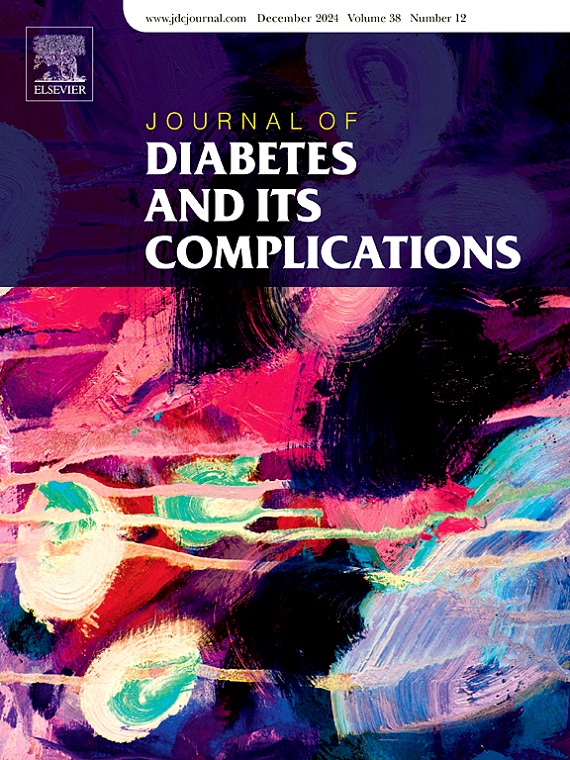Incremental value of CT-based perirenal fat characteristics in the categorization and progression prediction of diabetic kidney disease
IF 3.1
3区 医学
Q3 ENDOCRINOLOGY & METABOLISM
引用次数: 0
Abstract
Aims
To explore the association between computed tomography (CT)-derived perirenal adipose tissue (PAT) characteristics and diabetic kidney disease (DKD) risk categories according to the Kidney Disease: Improving Global Outcomes (KDIGO) guideline, and to determine the incremental predictive value of PAT characteristics for DKD rapid progression in patients with type 2 diabetes mellitus (T2DM).
Methods
404 patients with T2DM who underwent plain abdominal CT were categorized into four KDIGO risk groups (low, moderate, high, and very-high). The area and CT attenuation values of different abdominal fat deposits were measured. Logistic and Cox regression analyses were performed to identify risk factors for high and very-high KDIGO risk categories and predictors of DKD rapid progression.
Results
In multivariate logistic regression analysis, the PAT index (PATI) (P < 0.001), PAT attenuation value (P = 0.023) were independent risk factors for high- and very-high-risk KDIGO categories. In 125 patients with kidney function follow-up data, multivariate Cox regression analysis revealed that PAT attenuation value (P = 0.021) and haemoglobin (P = 0.031) were independent predictors of DKD rapid progression.
Conclusions
Patients with T2DM with higher PAT attenuation values and PATI exhibited an increased risk for higher DKD KDIGO risk categories. Baseline PAT attenuation values may have incremental value in DKD prognosis assessment.
基于ct的肾周脂肪特征在糖尿病肾病分类和进展预测中的增量价值
目的根据肾脏疾病:改善总体预后(KDIGO)指南,探讨计算机断层扫描(CT)衍生的肾周脂肪组织(PAT)特征与糖尿病肾病(DKD)风险类别之间的关系,并确定PAT特征对2型糖尿病(T2DM)患者DKD快速进展的增量预测价值。方法404例T2DM患者行腹部CT平扫描,分为4个KDIGO风险组(低、中、高、高)。测量腹部不同脂肪沉积的面积和CT衰减值。进行Logistic和Cox回归分析,以确定高和非常高KDIGO风险类别的危险因素和DKD快速进展的预测因素。结果经多因素logistic回归分析,PAT指数(PATI) (P <;0.001)、PAT衰减值(P = 0.023)是高、高危KDIGO分类的独立危险因素。在125例患者的肾功能随访数据中,多因素Cox回归分析显示PAT衰减值(P = 0.021)和血红蛋白(P = 0.031)是DKD快速进展的独立预测因子。结论具有较高PAT衰减值和PATI的T2DM患者发生较高DKD - KDIGO风险类别的风险增加。基线PAT衰减值在DKD预后评估中可能具有递增价值。
本文章由计算机程序翻译,如有差异,请以英文原文为准。
求助全文
约1分钟内获得全文
求助全文
来源期刊

Journal of diabetes and its complications
医学-内分泌学与代谢
CiteScore
5.90
自引率
3.30%
发文量
153
审稿时长
16 days
期刊介绍:
Journal of Diabetes and Its Complications (JDC) is a journal for health care practitioners and researchers, that publishes original research about the pathogenesis, diagnosis and management of diabetes mellitus and its complications. JDC also publishes articles on physiological and molecular aspects of glucose homeostasis.
The primary purpose of JDC is to act as a source of information usable by diabetes practitioners and researchers to increase their knowledge about mechanisms of diabetes and complications development, and promote better management of people with diabetes who are at risk for those complications.
Manuscripts submitted to JDC can report any aspect of basic, translational or clinical research as well as epidemiology. Topics can range broadly from early prediabetes to late-stage complicated diabetes. Topics relevant to basic/translational reports include pancreatic islet dysfunction and insulin resistance, altered adipose tissue function in diabetes, altered neuronal control of glucose homeostasis and mechanisms of drug action. Topics relevant to diabetic complications include diabetic retinopathy, neuropathy and nephropathy; peripheral vascular disease and coronary heart disease; gastrointestinal disorders, renal failure and impotence; and hypertension and hyperlipidemia.
 求助内容:
求助内容: 应助结果提醒方式:
应助结果提醒方式:


